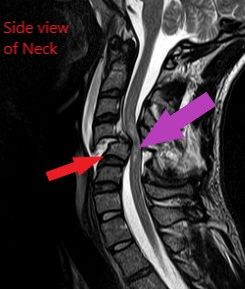DISCLAIMER: This article is not a medical diagnosis. It is an assimilation of neuromusculoskeletal knowledge and the available facts of the case.
Too Long/Didn’t Read
- Justyn Ross won’t play football in 2020 and will undergo surgery after suffering another “stinger” in March. X-rays revealed abnormal fusion of neck bones and he might have been diagnosed with Klippel-Feil syndrome (KFS).
- KFS causes a host of orthopedic issues due to abnormalities in the spine and can cause paralysis during physical activities like football.
- The risk of Ross stepping on a football field again is too high to anticipate he’ll play football again as of today.
What Is KFS?
In March Justyn Ross suffered, what appeared to be, a stinger. This led to x-rays of his neck and ended with the announcement today that he will miss all of the 2020 season. Based on the reports, Ross was born with abnormal fusion of two or more of his cervical vertebrae (neck bones). Given the known facts of the situation, Ross could have a number of conditions that affect the nerves and spinal cord. Considering the specific words used in reports (congenital fusion), one of those potential conditions is Klippel-Feil syndrome (KFS). KFS causes abnormalities in the vertebrae that aren’t fused together, such as narrowing of the space between the spinal cord and the vertebrae. At times, these people also have problems with the genitourinary system and/or the cardiovascular system. As time progresses, normal age-related changes in the neck, such as bony growths, affect people with KFS more severely and quickly due to already abnormal neck structures. The most dangerous issue of this rare condition is the instability of the first two cervical vertebrae which can lead to compression of the brain stem and/or spinal cord depending on the degree of involvement. This instability makes benign activities for the average person extremely dangerous for people with KFS and/or cervical instability. For example, throwing the head back too fast, doing a somersault, or falling from standing-height can cause paralysis because the motion of extension closes down the spinal canal. What activity is severe enough to potentially lead to these serious injuries and even death in people with instability? Football.
Below is a lateral (side view) of a person with a fracture and dislocation of the 4th cervical vertebrae (red arrow) that is compressing on the spinal cord (purple arrow). Usually, this type of injury is from an extremely high-energy accident. In people with KFS, this type of fracture/dislocation, if it does occur, will be higher in the spinal canal. It’s an illustration of why getting the back “adjusted” does not move bones back into place. In reality, this is a bone that is “out of place.”
Photo credit
What it Means
In his short time at Clemson, Ross has had issues with “stingers,” which is a transient compression of a nerve or from a big hit that causes the head to be violently thrown backward, making contact with nerves and in extreme cases, the spinal cord. The second type of injury can cause symptoms to radiate from the neck and should into one or both upper extremities. Stingers can cause numbness/tingling/pain, but typically resolve within minutes. If they don’t dissipate immediately, players might be shelved for several weeks such as Jordan Howard in 2019; but they generally are not a persistent problem. With the new knowledge that Ross has abnormal spacing of the spinal canal, whether he specifically has KFS or not, it makes sense that he’s had a history of “stingers” and it’s truly a miracle he’s played football as long as he has with no serious complications.
Summary
Given the fact that he’s played a violent game with no complications for so long, it’s likely that Ross has only a “mild” cervical spine condition but this does not minimize the danger he could be in if he continues to play football. Even after surgery, this will require lifelong monitoring from a healthcare team of physical therapists, nurses and neurologists. Right now, the concern should be with Justyn Ross the person, not the football player. Until further notice, don’t expect to see this talented receiver on a football field again.








